Read our latest issue below, or download a PDF version here for your reading device.
To request a print copy by mail, please email us at [email protected]. We will resume mailing for the Summer 2020 issue.
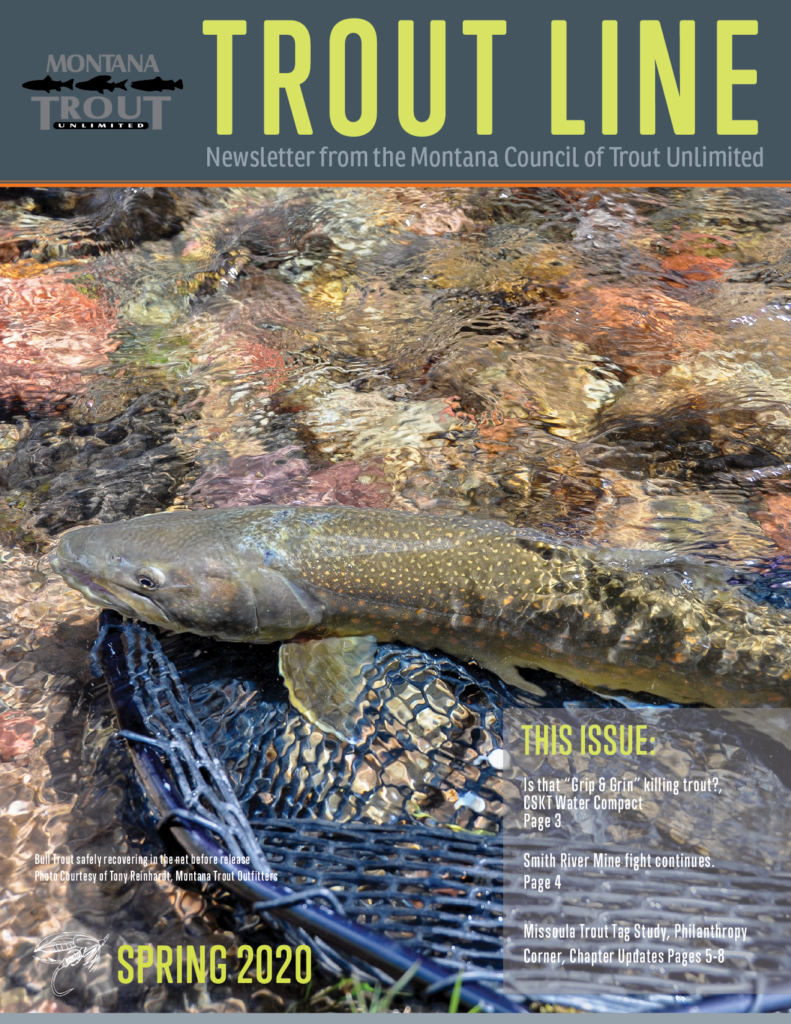
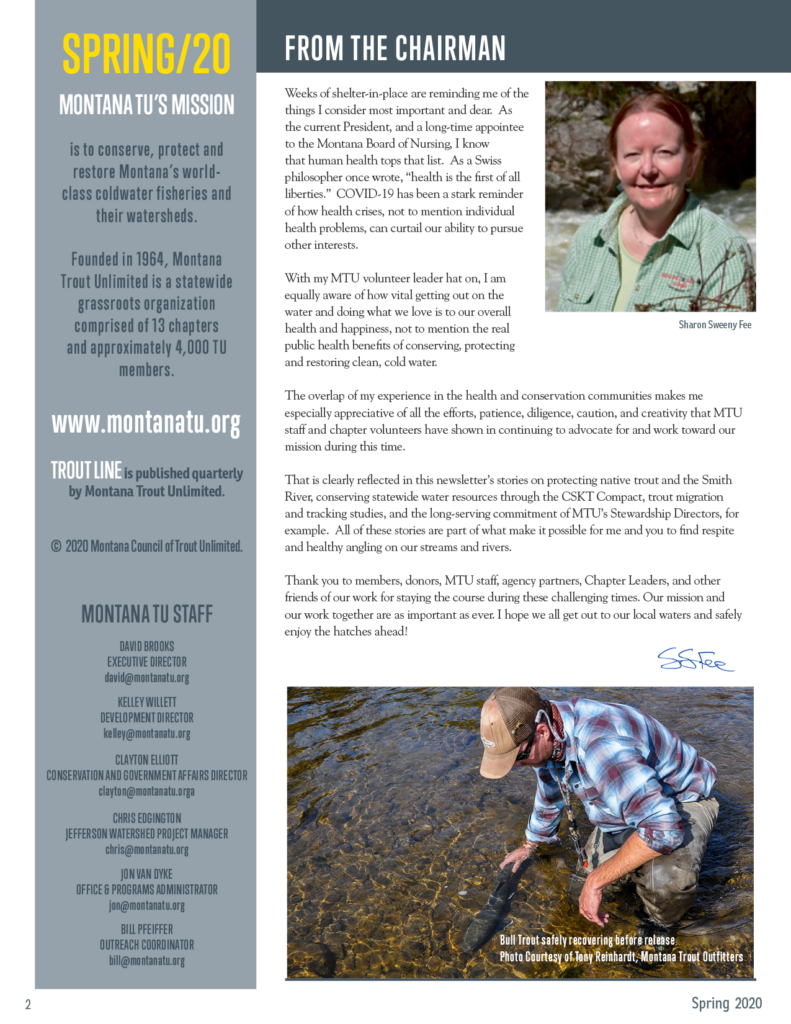
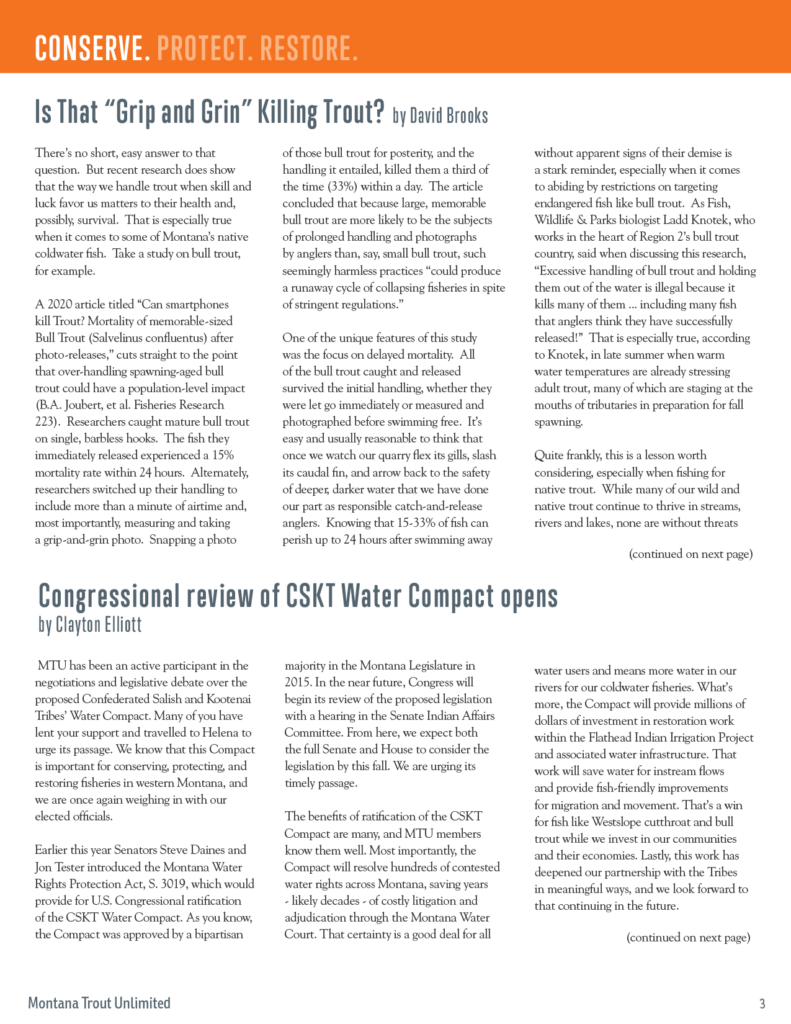
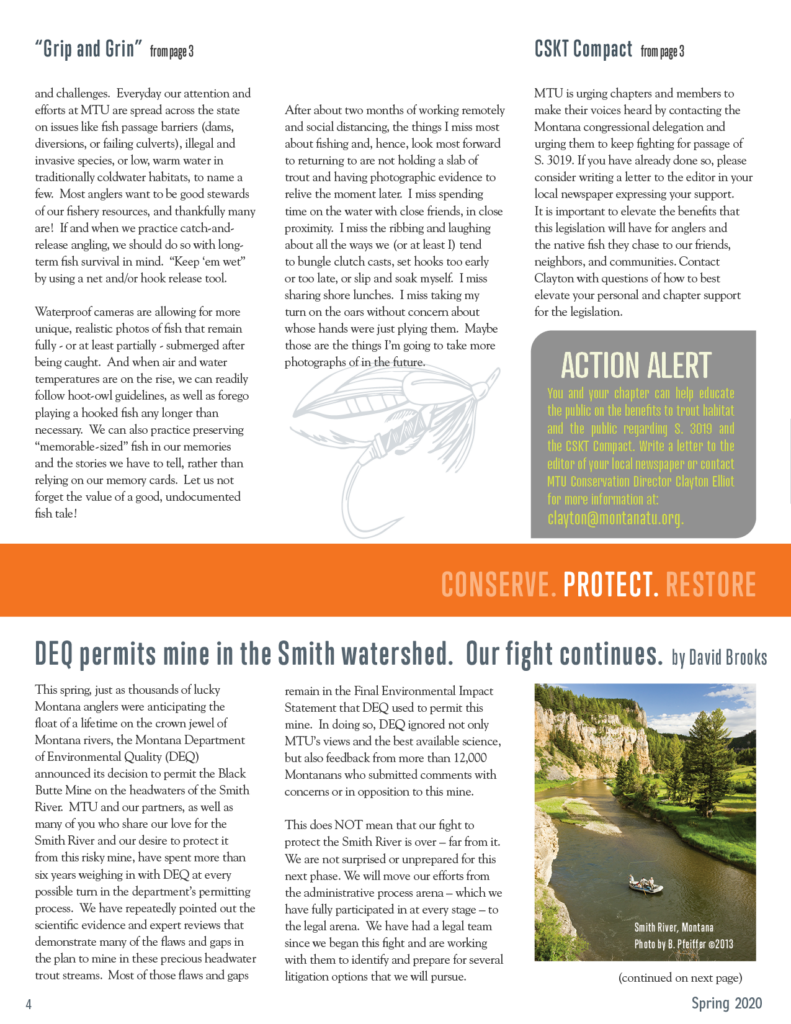
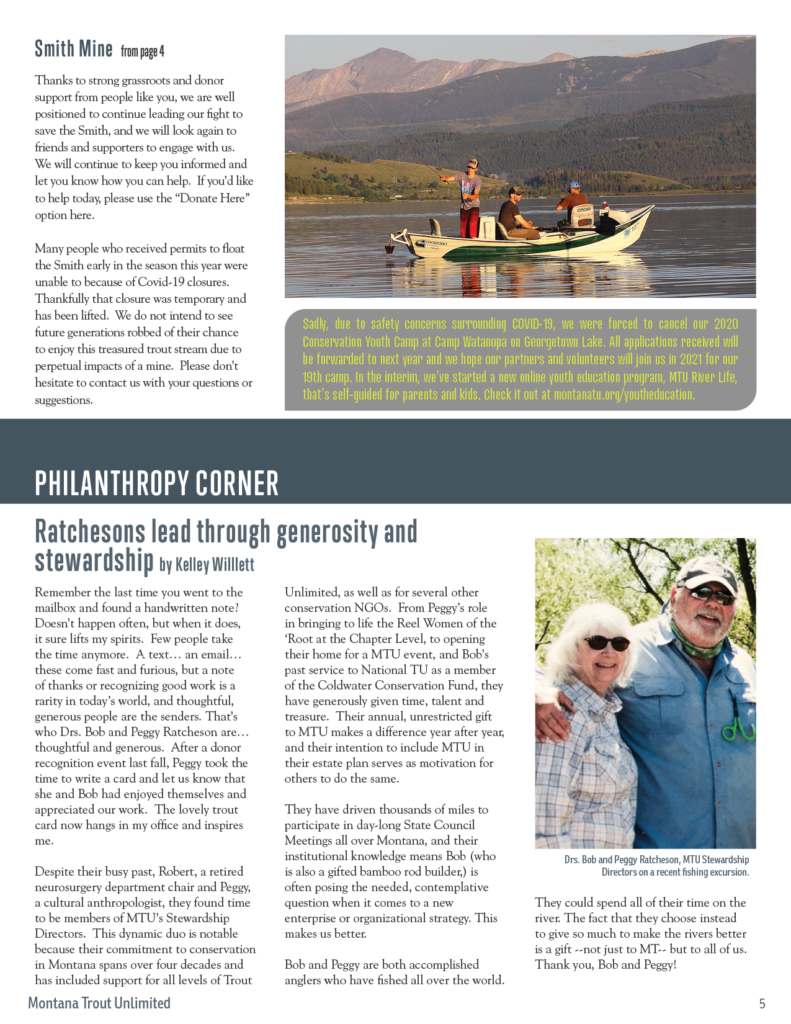
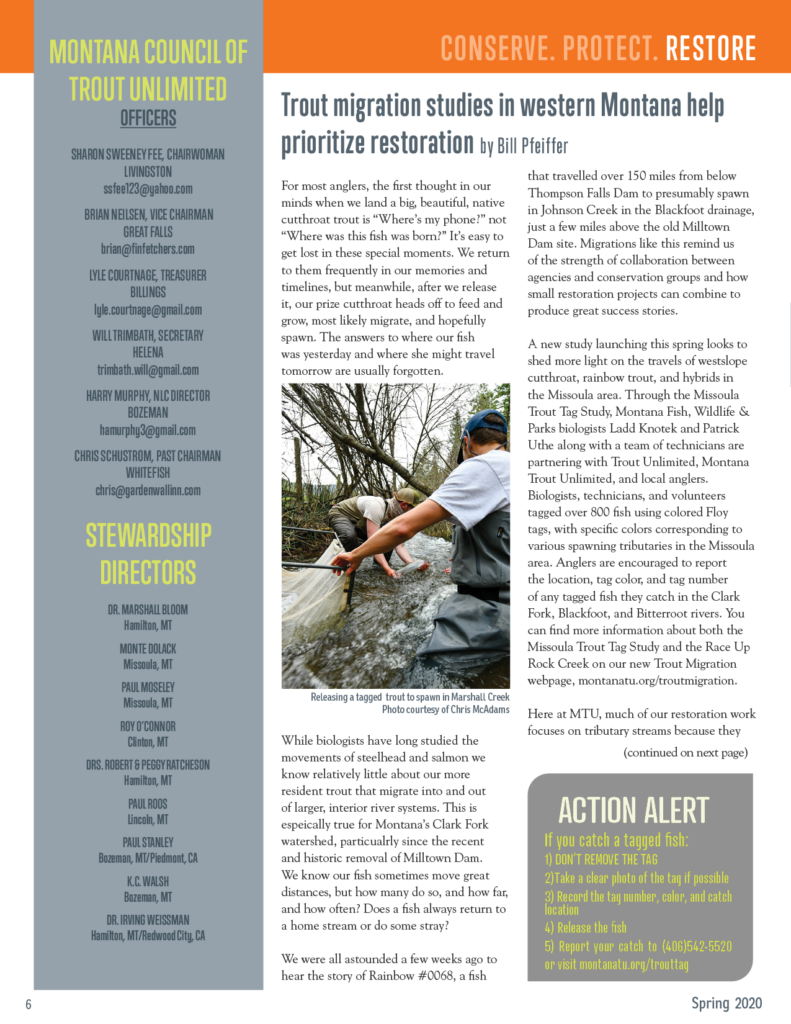
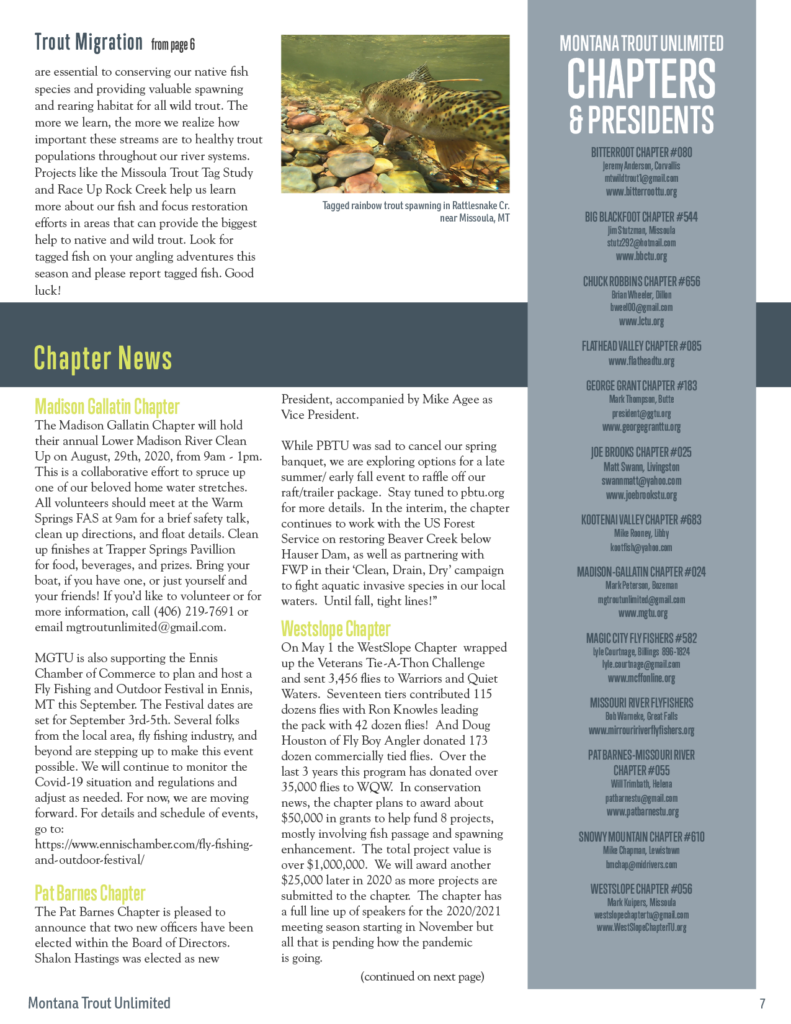
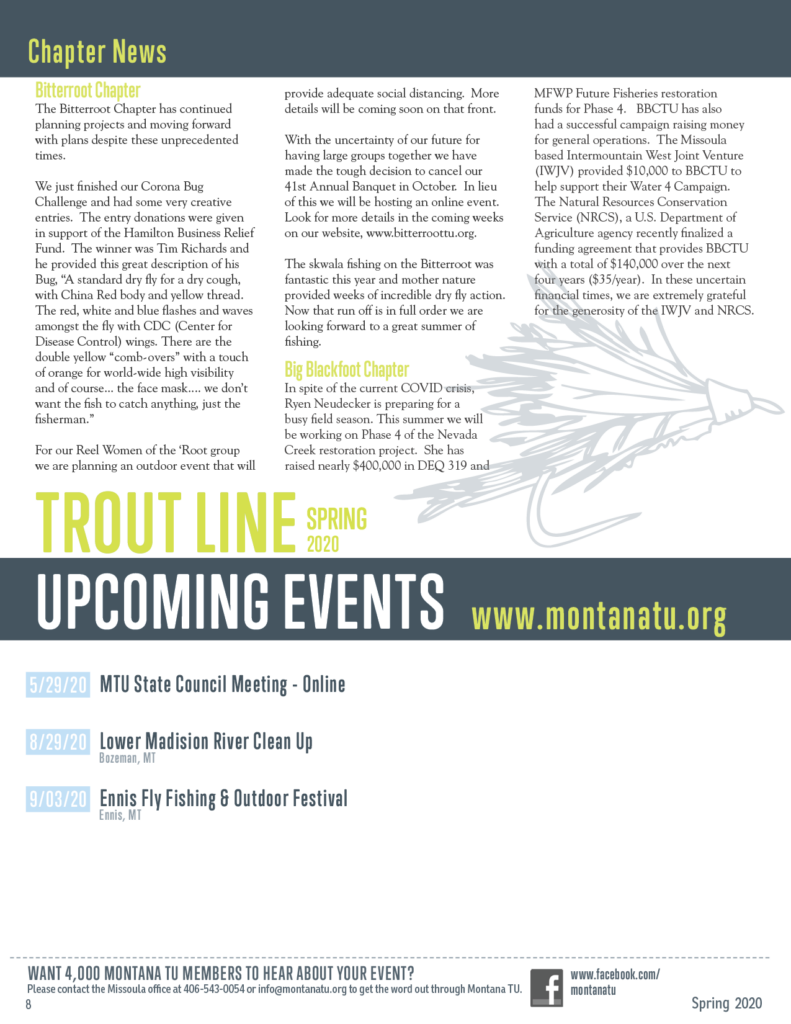

Read our latest issue below, or download a PDF version here for your reading device.
To request a print copy by mail, please email us at [email protected]. We will resume mailing for the Summer 2020 issue.








Our last year was one of our best ever, and we have high hopes for the future. Read our 2019 Annual Report to find out how we conserve, protect, and restore Montana’s coldwater fisheries.


An impressive migration was documented again this week by Patrick Uthe and Craig Podner (FWP Missoula). We had a 21 inch rainbow trout (3.5 lbs) that was captured in the Thompson Falls Fish Ladder March 25, 2020 and tagged with a Floy and PIT tag. It was released upstream, and then FWP recaptured it up Johnson Creek, a tributary to the lower Blackfoot River on April 27th, 2020. This is the furthest documented fish movement to date and the first documented connection from the Lower Clark Fork to the Blackfoot River system. In 33 days this rainbow moved upstream 150+ miles to where it likely hatched, to carry out its life history and presumably spawn.
When one collectively thinks about the independent restoration actions it took to have a positive cumulative effect it’s pretty remarkable. Starting in Johnson Creek where habitat conditions must be suitable enough for fish to spawn, survive the critical first couple of years, and then facilitate upstream return of adults, partners completed work that included; 3 culvert removals and installation of a bridge allowing for upstream fish passage, road decommissioning which improved habitat and reduced the risk of fine sediment delivery, and a three way protective land acquisition with Plum Creek, The Nature Conservancy, and Lolo National Forest. Several years ago this juvenile rainbow trout (now known as tag #0068) left Johnson Creek and moved downstream, the removal of Milltown Dam reduced a predatory population of nonnative northern pike from the reservoir. As this juvenile matured and instincts kicked in to return to its natal stream, the operation of the Thompson Falls fish ladder then started the upstream sequence and allowed access to the middle Clark Fork River. Again, the removal of Milltown Dam, allowed #0068 further access this Blackfoot River tributary, where it was trapped incidentally via another fisheries research project.
This success story supplements a similar migration by a rainbow trout to Rattlesnake Creek (in Missoula) via Thompson Falls Dam last spring.
These partnership efforts restore this possibility. The biological documentation linking all the actions is a notable feat. Montana Fish, Wildlife & Parks, Lolo National Forest, US Fish Wildlife Service, Big Blackfoot Chapter of TU, Trout Unlimited, The Nature Conservancy, and NorthWestern Energy are just a few of the key contributors to make this multi drainage success happen. Thank you to all the people who have been a part of these efforts up until now, and all those working towards a brighter future.
At Montana Trout Unlimited, we know how important the next generation of river stewards is to the future of conservation and sound angling ethics. That’s why for many years we’ve offered the Youth Fly Fishing and Conservation Camp each summer. We also know that with the reality of COVID-19, many people are home schooling their children and summer plans are uncertain for all of us. That’s why we created a crash-course for parents and kids in stream biology and ecology. Divided into 5 modules focused on different pieces of the river ecology mosaic, we’ve gathered lesson plans, fun handouts and activities you can download to do together, while creating fresh new video content to support your learning progress available on our YouTube page. Many of the materials here were developed by Margaret Sherriffs and Duncan Blair for TU’s Cold Water Conservation Education Guide (2002) and have been used at various youth camps for many years.
We also want you to share your experiences with us and other families. Tag us in your posts on Facebook and Instagram and use the hashtag #mturiverlife. We’ll send the best submissions some cool TU gear for sharing.
Check out our program below! We’ll update the lesson plan as we progress each week. New modules will be posted as we progress, with a live broadcast most weekdays at 11am Mountain Time that will fit into our weekly topic. Tune in to our Facebook and Instagram live and follow along with your family.
Learning Objectives:
Curriculum – Trout Bio Lesson 1 (parents download here)
Activities
Dear MTU Members and Friends,
Like so many of you, I’ve turned to video calls to keep in touch with my family, friends, coworkers, and partners in MTU’s mission. In addition to sharing COVID-19 news and helpful or funny stories about how we’re all dealing with orders to shelter in place or social distance, the most frequent topic of conversation on these calls is how we are all finding solace in getting outside. For me, and many of the people I interact with virtually, that means being on or near Montana’s rivers and streams. Because so many people, like me, are working remotely or, unfortunately are out of work for the moment, I’ve heard the admission, “I snuck out for a few hours and waded one of my favorite stretches of Secret Creek at lunchtime today,” or “My husband, son and I floated and fished the river yesterday and just took a break from thinking about this virus.”

But these stories about heading outside are about more than just a momentary escape. What I really hear from people is how being out, being on the water rejuvenates us. Something about standing thigh-deep in flowing water, being carried by the current, or simply walking alongside the rush of a creek fills us with the energy and positive spirit to return to our worlds of work or to face this crisis anew.
Yes, at Montana Trout Unlimited we pursue our mission to benefit trout. We also do so because we know the less singular values of cold, clean, connect and complex water. We love to fish. But we also know that healthy wild and native fish represent vital, thriving ecosystems, the kinds of places that heal and inspire people, the kinds of places we turn on carefree weekends or as shelter from crises.
Because you are a key part of our success and our community, I wanted to let you know that during this COVID-19 crisis, we will, to the best of our ability continue to work to conserve, protect, and restore these places in Montana. We are committed to doing so with the utmost caution for the health of our staff, volunteers, and the public. We are erring on the side of extreme caution. We are following all local, state and federal guidelines regarding the virus and how to contain its spread. Our offices are closed and we are working remotely. We are foregoing all face-to-face meetings and events in favor of virtual gatherings or rainchecks. We’re Zooming, Slacking, and old-fashion calling on the telephone, as well as exploring create ways to continue our conservation work and to engage our dedicated members and followers.
All of these things remind me of the good fortune I have of being surrounded by smart, motivated, fierce and fish-loving folks. We appreciate your dedication to our mission and our shared love of Montana’s coldwater streams and rivers. May they continue to inspire you through these times and well into the future.
Sincerely,

David Brooks
MTU Executive Director
This is a difficult time for all of us, but at least here in Montana, we are fortunate that we can still get out on the water for an escape. While many are choosing to fish alone for their own sanity and solace, there is no question that camaraderie on the river is important for many anglers. Fishing safely together with the reality of COVID-19 means that we need to be a little extra careful. We thought this would be a good time to encourage everyone to abide by some simple rules to make sure you stay safe, and you also keep fly shop employees, fishing guides, shuttle drivers, and our families healthy. A big thank you to Jake Walbridge at Montana Troutfitters and Mike Bias at FOAM for their help in compiling these tips. Stay safe out there and fish on!
 Make a plan for the day’s fishing to minimize time spent together in enclosed vehicles and other spaces.
Make a plan for the day’s fishing to minimize time spent together in enclosed vehicles and other spaces.Your local fishing spot is a great place to get away from the stress we’re all feeling right now. By following some simple guidelines, we can relax and have a little fun, while keeping our fishing friends happy, healthy, and safe. Tight lines from Montana Trout Unlimited.